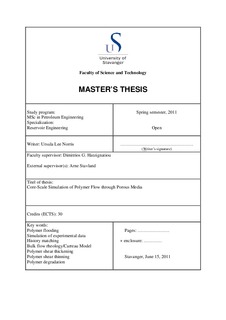| dc.description.abstract | From a multitude of laboratory studies conducted by various researchers during roughly the last 40 years (e.g. Hirasaki and Pope 1974, Heemskerk et al. 1984, Stavland et al. 2010), it has been identified that the behavior of partially hydrolyzed polyacrylamide (HPAM) polymer solutions in porous media is more complicated than what the bulk rheology might suggest. For decades, laboratory studies have reported the existence of shear thickening and degradation flow regimes when HPAM polymers have been exposed to high frontal velocities during corefloods. Recently developed models have displayed the capacity to accurately predict numerical values for the apparent viscosity behavior of HPAM polymers in the shear thickening and degradation flow regimes without in-depth data from coreflood experiments.
Having the ability to simulate this polymer behavior is valuable for selecting effective polymer flood design parameters, but doing this would be impossible if the simulation technology does not accurately reflect the experimental findings. This thesis sought to determine whether or not a commercially available simulator could accurately simulate results from both single- and two-phase polymer coreflood experiments conducted for a range of injection rates, which included rates that exhibiting polymer degradation behavior. The adherence to physically realistic input values with respect to experimentally derived parameters was of primary importance during the development of the models. When specific values were not available for certain simulation parameters, a reasonable range of values were investigated, and the best fitting results were selected. Through a methodical approach used to identify the best input values, two simulation models were created which produced results that were well matched with the experimental data. In the single phase simulation, the shear thinning, shear thickening, and degradation flow regimes were successfully modeled, but numerical issues arose for injection rates larger than 7.5 mL/min. In the two phase water-wet simulation, the modeled polymer behavior spanned from the shear thinning to the shear thickening flow regimes, but did not include the degradation behavior. With this model, both the pressures and cumulative oil production were successfully matched. Ultimately, understanding how to simulate the polymer behavior on a core-scale will improve the ability to model polymer floods on the field-scale. | no_NO |
